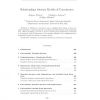Free Online Productivity Tools
i2Speak
i2Symbol
i2OCR
iTex2Img
iWeb2Print
iWeb2Shot
i2Type
iPdf2Split
iPdf2Merge
i2Bopomofo
i2Arabic
i2Style
i2Image
i2PDF
iLatex2Rtf
Sci2ools
102
Voted
REX
1993
1993
Relationships Between Models of Concurrency
Abstract. Models for concurrency can be classified with respect to three relevant parameters: behaviour/system, interleaving/noninterleaving, linear/branching time. When modelling a process, a choice concerning such parameters corresponds ing the level of abstraction of the resulting semantics. The classifications are formalized through the medium of category theory. Keywords. Semantics, Concurrency, Models for Concurrency, Categories. Contents 1 Preliminaries 431 2 Deterministic Transition Systems 433 3 Noninterleaving vs. Interleaving Models 436 Synchronization Trees and Labelled Event Structures . . . . . . . . . . . . . . 438 Transition Systems with Independence . . . . . . . . . . . . . . . . . . . . . . 439 4 Behavioural, Linear Time, Noninterleaving Models 441 Semilanguages and Event Structures . . . . . . . . . . . . . . . . . . . . . . . 443 Trace Languages and Event Structures . . . . . . . . . . . . . . . . . . . . . . 446 5 Transition Systems with Independence and Labelle...
Deterministic Transition Systems | Distributed And Parallel Computing | Event Structures | REX 1993 | Transition Systems |
Related Content
| Added | 10 Aug 2010 |
| Updated | 10 Aug 2010 |
| Type | Conference |
| Year | 1993 |
| Where | REX |
| Authors | Mogens Nielsen, Vladimiro Sassone, Glynn Winskel |
Comments (0)

